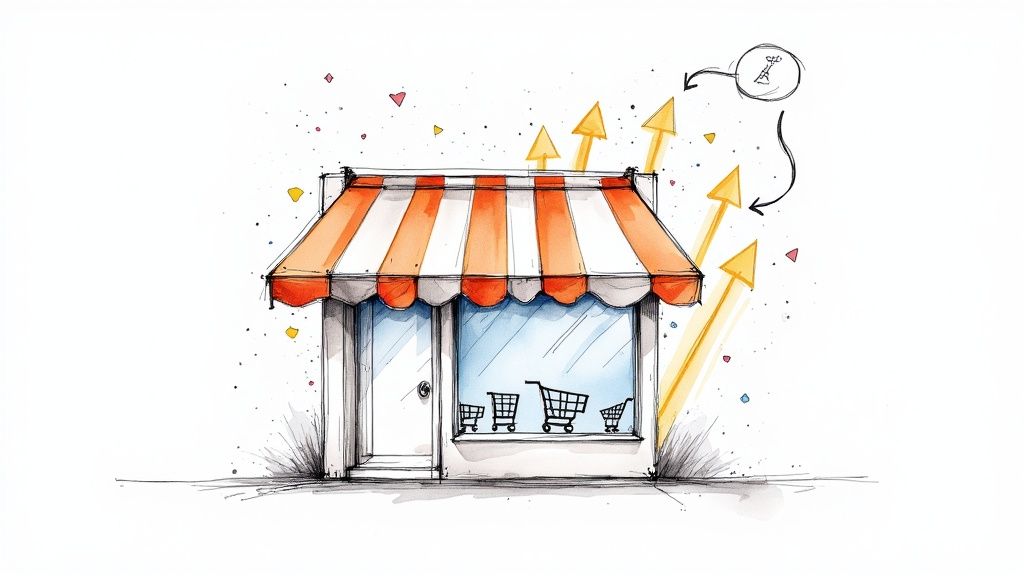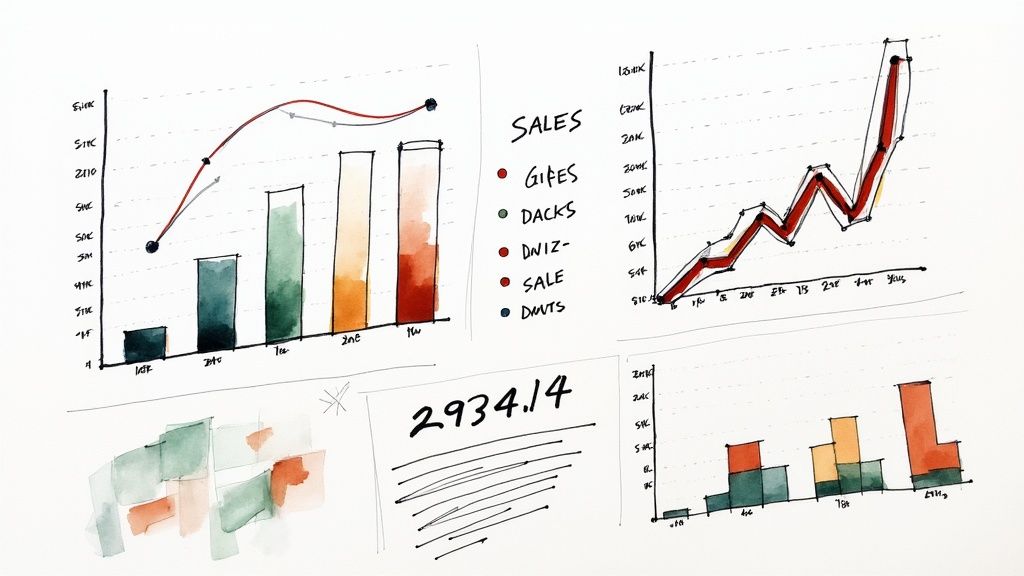Understanding Today's Ecommerce Landscape

Online retail continues to reshape how people shop and businesses operate. Smart companies pay close attention to how customers browse, compare, and buy products online. Understanding these shopping patterns helps businesses make better decisions about their online presence, whether that's optimizing for mobile shoppers or engaging through social media platforms.
Key Trends Shaping Ecommerce
The online shopping world keeps evolving in interesting ways. Personalization now matters more than ever – shoppers expect product suggestions and communications that feel made just for them. Artificial Intelligence (AI) helps companies handle repetitive tasks and make sense of customer data. More shoppers also care deeply about sustainability and ethical business practices, choosing to buy from companies that share their values.
The Growth of Ecommerce
The numbers tell a clear story about online shopping's growing importance. In 2023, US ecommerce sales hit $1.119 trillion, growing 7.6% from $1.040 trillion in 2022. Online purchases now make up 22.0% of all retail sales – the highest percentage since tracking began in 2000. This steady rise shows just how essential a strong online presence has become for growing businesses. For more details, check out Digital Commerce 360.
Adapting to the Changing Landscape
Success in online retail requires flexibility and quick responses to changes in shopping behavior. Smart businesses regularly check their data, watch market shifts, and adjust their approach as needed. This means having a mobile-friendly website, creating personal shopping experiences, and building genuine connections on social media.
Building customer trust remains crucial – provide excellent service, secure payment options, and clear business practices. When companies truly understand and adapt to how people shop online, they set themselves up for lasting growth and success.
Building a High-Converting Sales Funnel
A successful online store is the result of careful planning and strategy. The core of this strategy is a well-crafted sales funnel – a guided path that takes potential buyers from their first interaction to making a purchase. Each stage needs careful refinement to boost your online sales.
Optimizing Your Product Pages
Product pages are where sales happen. They need to present your items in a compelling way through excellent photos, clear descriptions, and persuasive text that prompts action. Adding product demonstration videos can increase sales significantly. Customer reviews also play a vital role by building credibility and helping shoppers make buying decisions.
Streamlining the Checkout Experience
Cart abandonment often happens when checkout is too complex or takes too long. The key is making checkout simple and quick. This means letting guests check out without creating accounts, asking for minimal information, and being upfront about shipping costs. Including popular payment options like digital wallets also helps shoppers complete their purchase with less friction.
Reducing Cart Abandonment
Every abandoned cart represents potential revenue. Smart email follow-ups can help recover these sales by reminding shoppers about items they left behind. Consider offering special incentives like free shipping or time-limited discounts to encourage completion. Making these emails personal based on shopping behavior tends to work better. Looking at conversion metrics helps track success – the average for online stores is around 3.23%, though this changes by industry. See the full statistics here.
Implementing Powerful Call-to-Actions
Call-to-actions (CTAs) direct visitors toward key actions like adding products to cart, joining email lists, or finalizing purchases. Effective CTAs use clear, brief, and eye-catching text. Action words like "Shop Now" or "Get Your Free Quote" create urgency and motivate immediate response. Place CTAs strategically across your site, especially on product and landing pages. Try different CTA versions to see what connects best with your audience and drives more sales.
Dominating the Mobile Commerce Revolution

Shopping on mobile devices has become the default choice for most online buyers. To succeed in this environment, businesses need to focus on creating smooth, engaging experiences that work perfectly on phones. Going beyond just having a mobile-friendly website, companies must design their entire shopping experience around how people actually use their smartphones.
Designing for the Mobile User
To create an effective mobile shopping experience, you need to understand how people browse and buy on their phones. Make navigation simple and intuitive – thumb-friendly buttons placed within easy reach allow one-handed use. Fast loading times are crucial since shoppers quickly abandon slow sites.
Think about trying to tap tiny, closely-spaced buttons on your phone screen. This common frustration drives many potential customers away. That's why proper mobile design focusing on usability makes such a big difference in keeping shoppers engaged.
The Power of Mobile Optimization
Good mobile design goes beyond just making your site responsive. You need to consider how mobile shoppers think and behave. One-tap checkout and mobile payment options like digital wallets remove friction from buying. This matches how people shop in quick bursts throughout their day. The potential is huge – mobile commerce sales will hit $2.07 trillion in 2024. Learn more about mobile commerce growth in Shopify's global ecommerce report.
Integrating App and Mobile Web Strategies
While a mobile-optimized website is essential, dedicated apps can create even better shopping experiences. Smart brands connect their app and mobile site strategies to give customers choice while keeping the experience consistent. For instance, an app might feature exclusive deals and personalized picks, while the website offers broader product browsing. This combined approach lets shoppers engage however they prefer while driving more sales through truly convenient mobile experiences.
Mastering Multi-Channel Traffic Generation
Building steady traffic to your online store requires more than relying on a single source. Much like a diversified investment portfolio protects against market volatility, spreading your marketing efforts across multiple channels helps create sustainable growth. When you combine different platforms strategically, you can reach more potential customers while getting better returns on your marketing budget.
Combining Organic Search, Paid Advertising, and Social Media
The most effective approach combines three key channels working together. Organic search brings free traffic through SEO by optimizing your site content with relevant keywords. Paid advertising on Google Ads and social platforms lets you precisely target specific customer segments. Social media helps build connections with potential customers through both regular posts and targeted campaigns. By using all three together, you create multiple pathways for customers to find your store.
Identifying and Targeting Your Most Valuable Traffic Sources
Some traffic channels will naturally work better for your specific business. Use analytics tools to track which sources bring in customers who actually make purchases. For instance, if Instagram drives more sales than Facebook, it makes sense to focus more effort there. Watch how customers move through your site from each traffic source to spot opportunities to improve their journey and boost sales.
Building Partnerships That Drive Consistent Sales
Working with complementary businesses and content creators can open up new customer streams. Partner with companies that share your target audience but don't directly compete. This builds trust and often leads to higher conversion rates – Adobe's research shows that referral traffic tends to convert particularly well. Look for partnerships that benefit both sides while expanding your reach to relevant new audiences.
Testing New Channels and Scaling What Works
Stay flexible and keep testing new approaches. Try out different ad formats, explore emerging social platforms, or experiment with new types of partnerships. Track your results carefully to see what connects with your audience. When you find something that works well, gradually increase your investment in that channel. Maybe that means spending more on successful ad campaigns or expanding your affiliate program. Keep testing, measuring, and adjusting to build steady growth over time.
Creating Trust-Building Customer Experiences

When shopping online, customers can't touch products or talk to staff face-to-face. That's why building trust is crucial for online stores. The best online retailers focus on creating trust throughout the entire shopping experience – from the first click to final purchase.
The Power of Social Proof
Just like checking restaurant reviews before trying a new place, online shoppers look for validation from others. Social proof shows potential customers that others have had positive experiences with your store. Here are key ways to showcase social proof:
- Customer Reviews: Show both positive and negative reviews to build credibility. Research shows that 93% of shoppers read reviews before buying
- User Photos & Videos: Let customers share photos and videos using your products on social media
- Customer Stories: Feature short quotes from happy customers on your website
- Partnerships: Work with respected voices in your industry to expand your reach
Writing Clear Product Descriptions
Good product descriptions answer customer questions before they ask them. For example, instead of just saying a winter coat is "warm," explain that it uses special insulation rated for temperatures below zero. Give specific details that help customers make confident buying decisions.
Supporting Customers Well
Quick, helpful customer service builds trust fast. Make it easy for customers to reach you through email, chat, and phone. When problems come up, fix them promptly and professionally. Have clear policies for returns and exchanges that customers can easily find and understand.
Making Checkout Safe & Simple
Use secure payment processing and clearly show security certificates during checkout. Be upfront about shipping costs and delivery times from the start. When customers know exactly what to expect, they feel more confident completing their purchase.
Sharing Helpful Content
Create useful blog posts, guides, and videos related to your products. If you sell running shoes, write about choosing the right shoes for different foot types or share training tips for beginners. This shows you understand your products and care about helping customers succeed.
Building customer trust takes consistent effort but leads to long-term success. Focus on being helpful, transparent, and reliable in every interaction. Small improvements in these areas add up to create an online store that customers return to again and again.
Implementing Data-Driven Optimization

Growing your online store starts with making decisions based on real data, not hunches. When you track and analyze how customers interact with your site, you can focus on what actually works to increase sales rather than wasting time on ineffective strategies.
Setting Up Effective Tracking
The first step is getting the right measurement tools in place. Install website analytics to monitor where visitors come from, how they behave on your site, and when they make purchases. Pay special attention to metrics like cart abandonment and average order size – these numbers tell you exactly where to improve.
Interpreting Analytics Data
Numbers alone won't help unless you know what they mean. Look for patterns in your site traffic, sales process, and customer actions to spot problems. For example, if lots of people leave certain product pages quickly, you may need better photos or descriptions. High cart abandonment could mean your checkout process is too complicated. Check your data regularly to catch and fix issues early.
Conducting Meaningful A/B Tests
A/B testing lets you try different versions of your pages to see what works best. Test one change at a time – like different product photos, headlines, or buy buttons – and measure which option gets more sales. This gives you clear proof of what convinces customers to buy, rather than just guessing.
Using Heatmaps and Session Recordings
Heatmap tools show you exactly where visitors click and scroll on your pages through color-coded maps. Session recordings let you watch real customer visits to spot where they get stuck or confused. Together, these tools reveal specific places where your site needs to be simpler or clearer for customers.
By consistently using these data analysis methods, you can keep improving your store based on how real customers shop. Focus on fixing the specific issues that stop people from buying, and test changes to make sure they actually help.
Ready to grow your online store's sales? MyAdForce makes it simple to run effective ads on Meta and Instagram, build sales funnels that work, and get more purchases from your traffic. Find out how MyAdForce can help boost your ecommerce revenue.

Laisser un commentaire